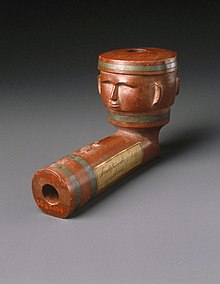
A cigarette is a narrow cylinder containing a combustible material, typically tobacco, that is rolled into thin paper for smoking. The cigarette is ignited at one end, causing it to smolder; the resulting smoke is orally inhaled via the opposite end. Cigarette smoking is the most common method of tobacco consumption. The term cigarette, as commonly used, refers to a tobacco cigarette, but the word is sometimes used to refer to other substances, such as a cannabis cigarette or an herbal cigarette. A cigarette is distinguished from a cigar by its usually smaller size, use of processed leaf, and paper wrapping, which is typically white. Most modern cigarettes are filtered, although this does not make the smoke inhaled from them contain fewer carcinogens and harmful chemicals.

Tobacco smoking is the practice of burning tobacco and ingesting the resulting smoke. The smoke may be inhaled, as is done with cigarettes, or simply released from the mouth, as is generally done with pipes and cigars. The practice is believed to have begun as early as 5000–3000 BC in Mesoamerica and South America. Tobacco was introduced to Eurasia in the late 17th century by European colonists, where it followed common trade routes. The practice encountered criticism from its first import into the Western world onwards but embedded itself in certain strata of a number of societies before becoming widespread upon the introduction of automated cigarette-rolling apparatus.

Smoking bans, or smoke-free laws, are public policies, including criminal laws and occupational safety and health regulations, that prohibit tobacco smoking in certain spaces. The spaces most commonly affected by smoking bans are indoor workplaces and buildings open to the public such as restaurants, bars, office buildings, schools, retail stores, hospitals, libraries, transport facilities, and government buildings, in addition to public transport vehicles such as aircraft, buses, watercraft, and trains. However, laws may also prohibit smoking in outdoor areas such as parks, beaches, pedestrian plazas, college and hospital campuses, and within a certain distance from the entrance to a building, and in some cases, private vehicles and multi-unit residences.

Halakha addresses a number of topics applicable to tobacco and cigarette smoking. These include the health impacts of smoking; the permissibility of smoking on holidays and fast days, and the impacts of second-hand smoke on other people.
Many religions have expressed positions on what is acceptable to consume as a means of intoxication for spiritual, pleasure, or medicinal purposes. Psychoactive substances may also play a significant part in the development of religion and religious views as well as in rituals.

Tobacco products, especially when smoked or used orally, have negative effects on human health. Researchers have addressed concerns about these effects for a long time. They have focused primarily on cigarette smoking.
The Islamic views on tobacco vary by region. Though tobacco or smoking in general is not explicitly mentioned in the Quran or hadith, contemporary scholars have condemned it as completely harmful, and have at times prohibited smoking outright as a result of the severe health damage that it causes. A tobacco fatwa is a fatwa that prohibits the usage of tobacco by Muslims. Arab Muslims tend to prohibit smoking and, in South Asia, smoking tends to be considered lawful but discouraged.
Herbal cigarettes are cigarettes that usually do not contain any tobacco or nicotine, instead being composed of a mixture of various herbs and/or other plant material. However, Chinese herbal cigarettes contain tobacco and nicotine with herbs added, unlike European and North American herbal cigarettes which have tobacco and nicotine omitted. Like herbal smokeless tobacco, they are often used as a substitute for standard tobacco products. Herbal cigarettes are often advertised as a smoking cessation aid. They are also used in acting scenes by performers who are non-smokers, or where anti-smoking legislation prohibits the use of tobacco in public spaces. Herbal cigarettes can carry carcinogens.

A hookah lounge is an establishment where patrons share shisha from a communal hookah or from one placed at each table or a bar.
Tobacco harm reduction (THR) is a public health strategy to lower the health risks to individuals and wider society associated with using tobacco products. It is an example of the concept of harm reduction, a strategy for dealing with the use of drugs. Tobacco smoking is widely acknowledged as a leading cause of illness and death, and reducing smoking is vital to public health.

Smoking is a practice in which a substance is combusted and the resulting smoke is typically inhaled to be tasted and absorbed into the bloodstream of a person. Most commonly, the substance used is the dried leaves of the tobacco plant, which have been rolled with a small rectangle of paper into an elongated cylinder called a cigarette. Other forms of smoking include the use of a smoking pipe or a bong.
In Judaism, a person who is shomer Shabbat or shomer Shabbos is a person who observes the mitzvot (commandments) associated with Judaism's Shabbat, or Sabbath, which begins at dusk on Friday and ends after sunset on Saturday.
In Qatar, the Constitution, as well as certain laws, provide for freedom of association, public assembly, and worship in accordance with the requirements of public order and morality. Notwithstanding this, the law prohibits proselytizing by non-Muslims and places some restrictions on public worship. Islam is the state religion.

Ventilated cigarettes are considered to have a milder flavor than regular cigarettes. These cigarette brands may be listed as having lower levels of tar ("low-tar"), nicotine, or other chemicals as "inhaled" by a "smoking machine". However, the scientific evidence is that switching from regular to light or low-tar cigarettes does not reduce the health risks of smoking or lower the smoker's exposure to the nicotine, tar, and carcinogens present in cigarette smoke.

Smoking in Syria is steadily increasing in popularity amongst the Syrian population, mainly in the forms of cigarettes or narghiles. In Syria, the General Organization of Tobacco manages the growth and exportation of tobacco products. Syrians collectively spend about $600 million per year on tobacco consumption. As of 2010, 20% of women and 60% of men smoke and 98% of the overall population is affected by passive smoking. Narghiles and cigarettes are the two main forms of tobacco consumption. Despite the assumption that smoking, specifically the narghile, is embedded in Syrian culture, this phenomenon has only recently become widespread. Health officials are currently working on smoking cessation programs and policies, to remove this idea that smoking in Syria is an essential part of the culture, to educate regarding health effects, and to prevent citizens from smoking in public places.

The use of tobacco products in Egypt is widespread. It is estimated that approximately twenty percent of the population uses tobacco products daily. Cigarettes are the most common form of tobacco consumption in Egypt, with an estimated twenty billion cigarettes smoked annually in the country. After cigarettes, shisha water-pipes are the most common form of tobacco consumption.

Smoking in Iceland is banned in restaurants, cafés, bars and night clubs as of June 2007. A large majority of Icelanders approve of the ban. At the time the ban went into effect, almost one in four Icelandic people were smokers.

Tobacco smoking is popular in North Korea and culturally acceptable among men, but not for women. As of 2014, some 45% of men are reported to smoke daily, whilst in contrast only 2.5% of women smoke daily, with most of these being older women from rural areas. Smoking is a leading cause of death in North Korea, and as of 2010 mortality figures indicate that 34% of men and 22% of women die due to smoking-related causes, the highest mortality figures in the world. There are tobacco control programs in North Korea, and although smoking was not prohibited in all public spaces, the smoking rates have declined since their peak in the 2000s.

Tobacco-free college campuses are colleges and universities that have implemented policies prohibiting the use of tobacco products at all indoor and outdoor campus locations. Tobacco is known to be harmful to the health of smokers, bystanders, and the environment. Since this issue was first recognized, colleges have been creating policies for tobacco use on campus in an effort to improve health standards, provide more enjoyable campus conditions, and to reduce the negative environmental effects of tobacco.














